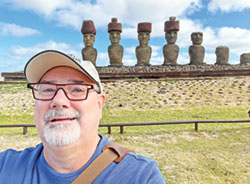‘Sacred Places’ exhibit focuses on world’s religions, including Christianity

To develop its “Sacred Places” exhibit, staff members of The Children’s Museum of Indianapolis traveled to different parts of the world to understand young people’s religious and spiritual beliefs. Chris Carron, the museum’s director of collections, visited Rapa Nui, Chile, to understand more about the stone statues, called moai, that represent ancestors and their importance in the spiritual traditions and daily life of this Pacific Island community, which is also known as Easter Island. (Photo courtesy of The Children’s Museum)
By John Shaughnessy
As the director of collections for The Children’s Museum of Indianapolis, Chris Carron had a key role in developing its new exhibit, “Sacred Places,” focusing on religious traditions from around the world.
Here is an edited version of an interview with Carron about the exhibit—and how the Catholic faith and Christianity are represented in the exhibit that is on display until April 7, 2024.
Q. Talk about the hopes of The Children’s Museum for the “Sacred Places” exhibit—and what led the museum to want to make it a leading focus.
A. “It is our hope that, by showcasing some of the world’s sacred places, we will foster curiosity and understanding of religious traditions so that people may better understand one another and communicate in thoughtful and respectful ways. The Children’s Museum has a history of tackling topics that are important to our community and of addressing subjects, like religion, that sometimes are avoided in public venues.
“We recognize the diversity of experiences of our audiences and wanted to provide a safe place for adults as well as families with children to see their own traditions and learn about and discuss the traditions of their neighbors.”
Q. What are some of the distinctive features of the exhibit?
A. “The exhibit includes stories and artifacts from more than two dozen sacred places representing a wide range of religious traditions around the world. Six of those [Buddhism, Christianity, Hinduism, Islam, Judaism and Rapa Nui] are treated as larger immersive environments with artifacts, large photo murals and interactives.”
Q. How did you decide upon The Beheading of St. John the Baptist Catholic Church in Madaba, Jordan, as a sacred place to represent Christianity?
A. “In creating this exhibit, we wanted real people to share their stories about what their sacred place means to them. So, we traveled across the country and around the world to interview young people about their sacred places.
“To capture these interviews, we teamed up with a company called CyArk, which produces photography and video stories across the globe and shares with us a respect and compassion for others’ cultural traditions. Their previous work documenting Byzantine Christian architecture and mosaics in Madaba, Jordan, had introduced them to the vibrant Greek Orthodox and Roman Catholic communities there, which they introduced to us.”
Q. How did you come upon 27-year-old Jude Anton Twal as a good person to represent Christianity and the Catholic faith?
A. “Jude is an architect and consultant for an archaeological museum in Madaba, whom our partners from CyArk had worked with before. They knew her to be not only good at her job, but also articulate about the Christian community there. During our team’s expedition to Madaba, we found that she was an active member of her parish [The Beheading of St. John the Baptist] who was willing to help our American visitors understand how she feels about her church and her faith.” †
Related story: An unlikely faith journey of 6,250 miles draws a young woman closer to Christ
